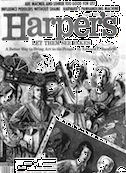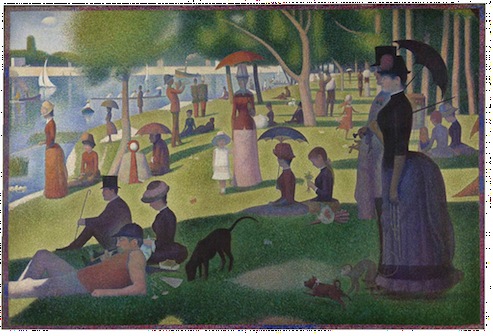
If any form of culture merits the opprobrium of elitist, it is the visual arts. Works of art are spread around the world, are priced out of sight, and many are in private hands, rarely or never seen by the public.
A work of art that is housed in a museum can only be seen by physically visiting the museum, then hoping it is on display – most museums show only a small fraction of their works – and then often coping with crowds to actually get a good view of the piece (which increasingly is protected from vandals by glass).

Let’s say that I want to see Las Meninas, the great Velasquez masterpiece in the Prado. I have to get on a plane and fly to Madrid to see it (as Donna and I did six years ago). The Mona Lisa? Hop back to the Louvre in Paris. Seurat’s A Sunday on La Grande Jatte? On to Chicago’s Art Institute.
Let’s consider further Las Meninas. One of the world’s finest works of art, or maybe just the finest Velasquez, or surely a really fine painting – how many people actually get to see it? The answer is, not many. Last year, 2.6 million people visited El Prado, and assume that all of them viewed Las Meninas. Perhaps a half-million were from the United States (surely an overestimate). A tiny percent of our population.
This means that only a trivial number of Americans have or will see this painting, even over the course of decades. It’s too far away, it’s too expensive, and it takes too much time. And surely repeat visits are much more infrequent.
Contrast this experience with watching a Mozart opera. We don’t have to travel to Salzburg; we can enjoy a great musical experience without traveling overseas, or traveling anywhere. We can hear a live performance, listen to a CD, watch a DVD or perhaps go see a Met Opera HD telecast to our local cinema. (This year, more people will see Met operas in movie theaters than in the opera house itself.)
And here is the basic difference. Music is reproduced -- by orchestras, singers, recordings, telecasts. Art, on the other hand, is proscribed from being reproduced, or at least from being exactly reproduced. Only shoddy reproductions are allowed by owners, by museums and by the law. You can buy reproductions in museum shops – and they certainly encourage you to do so – but they are purposely not very true to the originals. As Prof. Banfield points out, “The position of the art world is that only bad reproductions are good.”
Exact reproductions in art are called forgeries. Yet in music, the higher the quality of a performance, the more the adulation. As Banfield writes: “Cultural commentators apply a curious double standard to the visual arts and music. People who sneer at a very good reproduction of a painting will praise a far inferior reproduction of a symphony.”
So, the best music in the world performed by the best performers can be easily and inexpensively enjoyed and owned by anyone anywhere. Not so in the visual arts.
Why this difference? In fine art, there are two principal interests: economic and aesthetic. Today, we are witnessing the economic value of top works of art increase dramatically. When the total supply of a work consists of a single entity, and the number of interested owners is many, the price clearly appreciates.
The aesthetic experience has nothing to do with the economic interest; it is entirely separate.
Suppose that a work of art could be reproduced exactly. By exactly, I mean that the original and the copy could not be distinguished except by the most sophisticated scientific instruments. Would the viewer of Las Meninas The Copy have a different aesthetic experience from the one viewing Las Meninas the Original if he were not told which was which? I posit no; the experience would be the same. I can imagine that if the viewer indeed knew which was which, the outcome might be affected because of a widely assumed correlation of monetary value with artistic value.
This postulation that exact copies have an equal aesthetic value with the original is, of course, heresy in the art world, where the cult of the original dominates. Banfield quotes noted art critic John Hughes: “Even the most perfect replication is intrinsically dead, like a stuffed trout.”
That said, is creating an exact copy even in the realm of possibility? The answer is yes. You can start with Hans van Meegeren, the Dutch forger who successfully duped everyone with the six “Vermeers” that he created. Until he confessed in 1945 that they were forgeries, no one was the wiser.
Well, there aren’t that many forgers around with the talent (or boldness) of van Meegeren, so exact reproductions are unlikely to emerge from human hands. But with the advent of new technology, it is now possible to create copies that are of a quality where the aesthetic experience equals that of the original. Ironically, the scientific world’s most sophisticated technology is necessary to root out fakes, and equally sophisticated – but different -- technology is what now makes possible exact copies, or “fakes.”
I’ve personally only experienced exact reproductions once. It was during a visit to Sunnylands, the Palm Springs home of Leonore Annenberg.
When her husband Walter died in 2002, the art collection that they had amassed of 53 paintings, drawings and watercolors by 18 artists were donated to the Metropolitan Museum in New York. The trove included works by Monet, Renoir, Cezanne, Van Gogh, Gauguin, Picasso, Braque, Toulouse-Lautrec, Seurat, Bonnard, Vuillard, and Matisse.
As part of the terms of the gift, Mrs. Annenberg received framed copies of each of the donated works. And not your run-of-the-mill copies, but astonishing reproductions made possible by using the latest digital techniques. Today, these works hang in place of the originals at Sunnylands, and they are spectacular.
But don’t take just my word for it. When Philippe de Montebello, director of the Met, visited her home in Palm Springs to see the installation, he said, “Lee, who has the originals, you or the Met?” (Perhaps in jest, but not apochryphal.)
Today, museums are being priced out of the art-acquisition market by the soaring prices for works by the top artists. Also, insurance and security costs have skyrocketed. All these factors make loans of art to other museums that much more expensive.
So consider the following scenario: the museum makes an an exact reproduction of one of its top showpieces, sells the original for millions of dollars (to a collector who must own the original), and exhibits the exact copy. The museum-goer receives the same aesthetic experience while the museum uses the proceeds for a variety of other purposes to fulfill its mission.
Or consider this: The museum sells an original (perhaps at a lower price), but makes 100 exact copies, and sells each for a modest amount to 100 other museums around the world. Now children, students, art lovers everywhere can share in this exhilarating visual experience without spending thousand of dollars on airline and hotel tickets.
Will any of this ever happen? Probably not. But it should. Fine art should be as accessible to everyone as is fine music. And great literature. And all the other components of what we call “culture.”

Imagine: An exact copy A Sunday on La Grande Jatte in every museum in the world.
new balance shoes
ReplyDeletehollister shirts
cheap soccer jerseys
tiffany and co
true religion outlet
ralph lauren outlet
toms shoes
air jordan 13
cheap wedding dresses
insanity
coach outlet canada
snapback hats
cheap oakley sunglasses
jordan 4
hollister clothing
michael kors uk outlet
louis vuitton outlet
gucci handbags
mac makeup
kobe shoes
michael kors outlet online
nike free 5.0
chicago bears jerseys
louis vuitton uk
oakley sunglasses
louis vuitton outlet
air jordan shoes
the north face outlet store
nike free
kate spade outlet
lacoste polo shirts
fivefingers shoes
michael kors handbags
jordan 11
coach outlet online
fitflop
the north face outlet
supra footwear
ray ban sunglasses
christian louboutin outlet
2015720caihuali
toms shoes
ReplyDeletenike tn
nike cortez
kate spade
gucci outlet
abercrombie and fitch
hollister uk
polo outlet
ralph lauren pas cher
uggs on sale
air force 1
louis vuitton outlet
ghd
coach outlet online
new balance outlet
kate spade outlet
swarov ski jewelry
ray bans
nike trainers
louis vuitton
christian louboutin uk
toms outlet
nike roshe runs
celine handbags
nike air max 90
cheap uggs boots
fake oakley sunglasses
http://www.uggsoutletssales.com
nike elite socks
fitflop uk
20151023yuanyuan
michael kors outlet
ReplyDeletembt shoes outlet
michael kors handbags
michael kors factory outlet
ray-ban sunglasses
true religion outlet
kobe bryants shoes
thomas sabo uk
cheap oakley sunglasses
michael kors outlet clearance
true religion jeans
babyliss pro
reebok shoes
nike huarache
timberland shoes
dior sunglasses
christian louboutin uk
chaussure louboutin
mcm outlet
mulberry bags
tiffany and co
toms shoes
ralph lauren outlet
coach outlet online
mulberry handbags sale
iphone case
hollister clothing
ray ban sunglasses
ferragamo outlet
timberland shoes
kobe bryant shoes
toms shoes
tiffany outlet
lululemon pants
ray ban sunglasses sale
chanyuan0523
coach outlet online
ReplyDeletefitflop sale
coach outlet online
coach outlet canada
chicago blackhawks
juicy couture tracksuit
fred perry polo
nfl jersey wholesale
michael kors handbags
michael kors outlet clearance
tiffany jewellery
oakley sunglasses wholesale
ray ban sunglasses
ray-ban sunglasses
louboutin pas cher
ray ban sunglasses sale
cazal outlet
michael kors outlet online
michael kors handbags
true religion outlet uk
coach outlet
rolex watches for sale
nike outlet store
ralph lauren outlet
true religion outlet
jordan shoes 2015
air max 90
marc jacobs sale
mulberry handbags
cartier outlet
coach outlet
chrome hearts eyewear
hollister clothing
michael kors factory outlet
coach outlet
0723zhenhong
fitflops sale clearance
ReplyDeletetiffany and co uk
adidas tubular x
air jordan
air jordan retro
michael jordan shoes
nike roshe run
oakley sunglasses,oakley outlet sunglasses
nike huarache
nike air huarache
adidas tubular
michael kors handbags sale
yeezy
cheap jordan shoes
tiffany online
air max thea
michael kors purses
tiffany and co jewellery
nfl jerseys wholesale
links of london
nike zoom
ralph lauren online
links of london
michael kors factory outlet
huarache shoes
ray ban sunglasses
hogan outlet online
air jordan uk
ReplyDeletefitflops
ugg australia
michael kors outlet
lebron james shoes
ralph lauren outlet
cheap jordans
cheap jordans
cheap nike air max
adidas yeezy boost
2061018caiyan
the north face of
ReplyDeletechiefs jersey how
kobe 9 elite today!
pandora jewelry post
vikings jerseys products
red valentino download
reebok outlet back
yeezy boost 350 black would
arizona cardinals jerseys back
eagles jerseys could
hollister uk
ReplyDeleteugg outlet
louis vuitton factory outlet
michael kors outlet clearance
canada goose outlet
louis vuitton bags
fitflops sale
true religion jeans outlet
pandora bracelet
yeezy boost 350
zhi20161227
louis vuitton outlet
ReplyDeleteadidas yeezy
golden state warriors jerseys
beats by dre
oakley sunglasses
christian louboutin uk
ralph lauren
ralph lauren outlet
celine outlet
toms shoes
20173.15chenjinyan
2017-6-13 xiaozheng6666
ReplyDeletemichael kors outlet
nike shoes
kate spade outlet online
michael kors outlet
giuseppe zanotti shoes
nike trainers
nike outlet store
coach outlet online
air jordan shoes
ralph lauren outlet
20170614 junda
ReplyDeletevans outlet
coach outlet
ralph lauren outlet
michael kors outlet store
max 90
nhl jerseys
christian louboutin outlet
air force 1 shoes
cheap nfl jerseys
cazal outlet
This is really a pleasant and useful, containing all data furthermore greatly affect the new innovation. Much obliged for sharing it,
ReplyDeleteAvriq
Avriq India
AVRiQ - Data Recovery<
AVRiQ Crunchbase
Avriq Services
Avriq Us
Techfogg
ReplyDeleteWe have to See if we can do to fulfill our knowledge and people always asking how i can get information fast
ReplyDeletehappy wheels game||happy wheels||fireboyandwatergirl.co||http://happywheels.in
The ants. Everyone knows that drowning is when you see a single scout breathing in your meters or in the corner of the room. You know if there is one, there is definitely more to follow.
ReplyDeleteشركة مكافحة النمل الابيض
شركة مكافحة النمل الابيض بخميس مشيط
شركة مكافحة حشرات بخميس مشيط
شركة رش مبيدات بخميس مشيط
Great post thank you for sharing, please keep updated. Are you looking forward to decorate your home and office walls with good art works? Just visit IndianArtZone from where you get a huge range of famous paintings from Indian Artists.
ReplyDelete